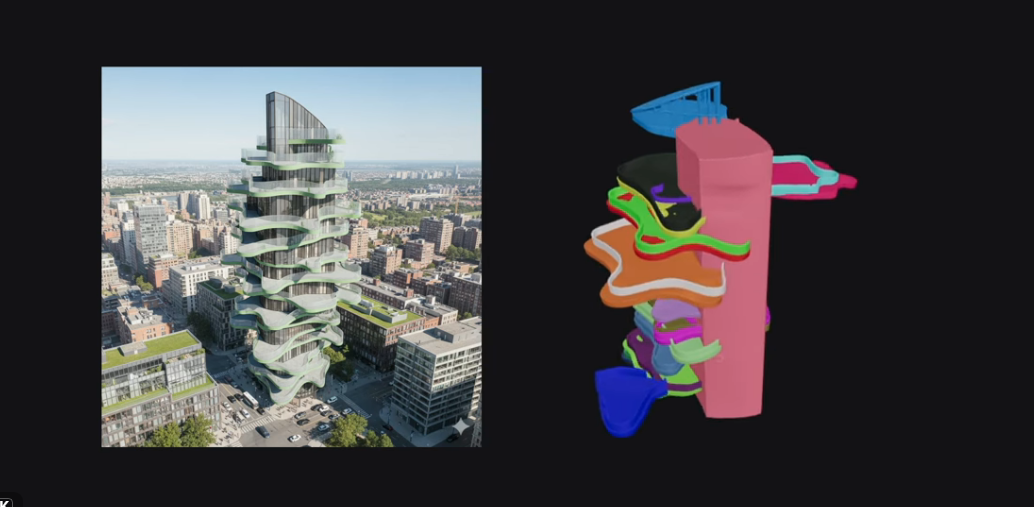AI-Driven 3D Segmentation Is Changing the Way We Model
Turning 2D images or fused 3D meshes into editable geometry used to be painful. If you’ve ever converted a sketch or render into 3D, you know the frustration of working with a single, uneditable mesh. You could orbit around it, but you couldn’t really refine it.
That’s beginning to change. AI-driven segmentation tools can now take an image or a rough 3D model and automatically separate it into logical layers — walls, roofs, terrain, furniture, trees, even small architectural details. Instead of one fused object, you get a structured model you can actually work with.
What’s Behind the Shift
Traditional 3D reconstruction tools treated the entire model as a single object. That worked for visualizations but made editing nearly impossible. Now, segmentation models use computer vision and neural geometry networks to detect boundaries and assign each part to its own layer.
Platforms like Tencent’s Hunyuan 3D (Hanuan) and Tripo 3D Studio are pioneering this for design and visualization workflows. Both allow you to upload an image or model, process it through an AI segmentation pipeline, and receive a model split into editable components — balconies, roofs, facades, even terrain layers.
In tests, Hunyuan’s automatic “part splitting” tool performed surprisingly well for architectural forms that weren’t even part of its original training data. Tripo’s version adds manual control with brush-based layer refinement, smart part completion, and topology cleanup.
While the segmentation still struggles with precision around windows, glass edges, and small façade details, it’s a leap forward compared to the one-piece meshes most of us are used to.
Why This Matters for Architecture and Design
AI-based 3D segmentation is more than a novelty. It changes the front end of the design process in a few important ways:
Rapid concept refinement. Designers can start with an AI-generated massing or imported mesh and quickly isolate parts for editing, without manually re-modeling.
Streamlined reverse engineering. Scanned or photogrammetry models can be separated into logical elements for measurement, cleanup, or BIM conversion.
Smarter pipelines for training and automation. Segmented geometry creates structured datasets that can feed into machine learning models for generative design or automated documentation.
Cross-discipline flexibility. Engineers, fabricators, and visualizers can each interact with their relevant layer of a model, instead of flattening geometry for compatibility.
Research from NVIDIA and Tencent Labs indicates that multi-view diffusion models can now infer 3D structure from a single or limited image set, while point-cloud segmentation networks achieve up to 90% accuracy on complex object separation. These advances are being quietly integrated into creative tools.
What Comes Next
Expect three areas of evolution over the next year:
Custom training for building typologies. Most 3D segmentation models are trained on characters and vehicles. Training them specifically for architectural geometry could yield much higher accuracy on façades, openings, and materials.
Integration with parametric tools. Soon, segmented geometry could flow directly into Rhino, Revit, or Blender with editable parameters intact.
AI-assisted topology optimization. Some platforms already hint at adaptive retopology that adjusts density based on design intent, ideal for massing and early BIM translation.
We’re entering a stage where image-to-3D tools are no longer static visualization gimmicks. They’re becoming functional entry points to design. The ability to segment, tag, and manipulate geometry instantly is redefining how architects sketch, iterate, and build.
AI-driven 3D segmentation won’t replace modeling expertise, but it will finally let us focus on design decisions rather than digital cleanup.
If your firm is exploring AI workflows for 3D modeling, digital twins, or parametric automation, I’d be happy to connect. Book a strategy call with Matechi to learn how these tools can accelerate your concept-to-model pipeline.
Book a call → https://matechi.as.me/
